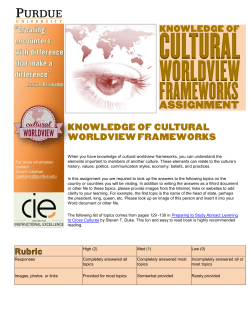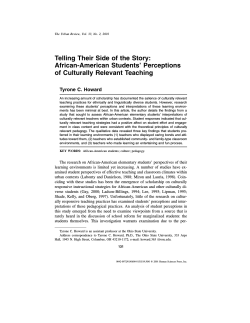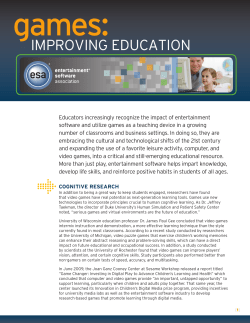
Document 199892
2012 International Conference on Language, Medias and Culture IPEDR vol.33 (2012) © (2012) IACSIT Press, Singapore Why and How to Apply Culture in an EFL Classroom? Mohammad Pourmahmoud Hesar 1, M. Yavuz Konca 2, Elham Zarfsaz 1 3 Iranian Academic Center for Education, Culture and Research (ACECR), Department of Information Technology, Urmia, Iran 2 PHD, K.K. Education Faculty, English Department, Ataturk University, Turkey 3 PHD Student at Ataturk University, Turkey Abstract. Culture as an integrative part of language is neglected or deliberately ignored in EFL classes. However learning a foreign language does not just mean to acquire the structure of the language and how to use language skills perfectly. Language classroom must explicitly and implicitly address cultural elements in a way that as Corbett puts, learners are encouraged to function within the new culture while maintaining their own culture[1]. The main goal of culturally responsive pedagogy is student's academic success. To achieve the goal teachers can apply technology to their classes. With the use of culture-reflecting technology in EFL classes students can express and share their culture with others and teacher can use these tools as a means of showing care and interest in students culture. Technology based application of digital storytelling tools such as Microsoft movie maker and Photo story can foster learning in a culturally responsive classroom. Key Words: Culture, Culture and Language teaching, Culturally responsive Pedagogy, Technology and Teaching Culture 1. Introduction It has mostly been forgotten that a full mastery of a language does not just mean understanding the rules and using the four skills perfectly. It also requires a full mastery of the culture of that language. In foreign language classrooms, in English as a foreign language (EFL) classes for instance, language providers mostly fail to provide language learners with the cultural aspects of the target language It is now a widely accepted fact that language classrooms must both implicitly and explicitly address the cultural elements of the targeted language. However, it should be noted that language teachers should not be after ‘enculturation’, which according to Corbertt is “the assimilation of learners into the host culture”[1], in their classrooms while they are exposing their learners with the culture of the target language. They, conversely, should be finding ways to foster ‘acculturation’ which, again in Corbett’s words, is “the process by which learners are encouraged to function within the new culture while maintaining their own culture. While teachers need to seek ways to acculturate their students, they also need to be understanding and responsive to students’ own cultures. As put forward by Gollnick and Chinn, a growing number of students from culturally and linguistically diverse backgrounds populate modern language classrooms today and “efforts mount to identify effective methods to teach these students” while “the need for pedagogical approaches that are culturally responsive intensifies” [2]. 2. Culture and Language Teaching While for Davis culture is an “important survival strategy that is passed down from one generation to another through the process of enculturalization and socialization, a type of road map that serves as sense making device that guides and shapes behavior” [3], for Owens culture is “what one thinks is important 1 2 3 mohammad_pus@yahoo.com ykonca@hotmail.com elhamzarfsaz7@gmail.com 68 (values); what one thinks is true (beliefs); how one perceives how things are done (norms)” [4]. Though the definitions vary, there is an eminent reality that culture is composed of various elements, each is vitally necessary to be able to see the full picture of the culture of a society. These elements include traditions, myths, values, norms, customs, legends, history, religion, civilization, and the geographical location. Culture is a puzzle, and its elements are the pieces. Each piece--element--must be considered and understood; otherwise, it would not be probable to have a clear understanding and vision of that culture. In language learning culture is significantly important and is an item that cannot be disregarded because, culture acts as if the flesh and language as the skeleton of a society. We know that language and culture are strictly intertwined and if there is no culture, there is no language. Therefore, a language class cannot be imagined without involving the cultural elements of the targeted language. Imagine the first day in a classroom where the target language is Persian. The instructor of that class would most probably start with teaching how to greet people in Persian. This very first day of the class would vividly reflect the cultural elements of Iran since the greetings would be carried out in the Iranian way. Same for an English as a Foreign Language (EFL) class: No matter where this class is on the planet, the greeting patterns would involve cultural patterns of the British or American cultures. In both classes, the learners might not notice and the teacher might be fully aware, but the cultures of both languages are presented and practiced in these classes even in the very first day of the class. 3. Definition of Culturally Responsive Classroom Our classrooms are becoming more multilingual and more multinational under the irretrievable effects of globalization. This situation drastically increases the importance of culturally responsive pedagogy. Before explaining what culturally responsive pedagogy is, it should be noted that this term is used interchangeably with several terms such as culturally responsible culturally appropriate, culturally congruent, culturally compatible, and culturally relevant. All these terms indicate that teachers need to be responsive to their students by integrating some elements of the learners’ culture in their teaching. That means that teachers need to meet their teaching objective, making use of the concepts, speeches, images, films, and/or materials that are familiar to the students. To exemplify, let’s imagine a culturally responsive multinational writing class where students from diverse backgrounds coexist, and the target subject of the class is writing an expository paragraph. A culturally responsive task to do in this class would be, for example, utilizing the proverbs of students from different countries. Students might be given a piece of paper with a list of proverbs from the home countries of the students in the class. They may be asked to choose one of the proverbs (not the ones from their home country) and write an expository paragraph. This simple task would not only increase students’ awareness of the cultural values and norms of other cultures but also might make them see that there are similarities between their and the other cultures since proverbs carry very similar messages across cultures. Another culturally responsive task to do in a multinational class is using a speech or text from the home country of some students. The famous texts like the Declaration of Independence or Magna Carta can be utilized. For instance, a reaction-response paragraph activity can be designed with such texts: students might be asked to react to some of the ideas presented in the texts. 4. Culture and Language Teacher Gay reported that teacher trainer programs should prepare their trainees to work with diverse students in multinational classrooms. Gay indicates that there are five important areas that need be involved in teacher training programs. These areas are as follows: Developing culturally diverse knowledge base, designing culturally relevant curricula, demonstrating cultural caring and building a learning community, building effective cross-cultural communications, and delivering culturally responsive instruction [5]. Brown claims that to be able to demonstrate cultural caring and building a learning community, teachers should use “cultural scaffolding—that is students’ cultures and experiences—to expand their intellectual horizons and academic achievements”. They also should emphasize holistic or integrated learning; rather 69 than making different types or learning (cognitive, physical, emotional) discrete, deal with them in concert [6]. 4.1. Characteristics of a Culturally Responsive Teacher A responsive teacher is sensitive to the needs, interests, learning preferences, and abilities of their students. Moreover, these teachers do not implement the same kinds of activities in their classrooms all the time and never follow the same teaching methods and materials. Gay states that culturally responsive teachers need to utilize the three dimensions within the culturally responsive teaching framework: a) Academic achievement: Teachers aim to make learning meticulous, exciting, and challenging. b) Cultural competence: Teachers know and facilitate in the learning process the various range of students’ cultural and linguistic groups. c) Sociopolitical consciousness: Teachers need to recognize and assist students in the understanding that education and schooling do not occur in a vacuum (Brown). Barnes believes that the interaction among these dimensions would help teachers considerably meet the needs and expectations of a diverse classroom [7]. Another important aspect of culturally diverse teachers are mentioned by Irvine and Armento. They state that culturally responsive teachers make use of the classroom and non-classroom time to have a better understanding of the cultures of their students. In or out of class, culturally responsive teachers try to develop personal relations with their students, and they do not do that at random intervals. Developing personal relation with students is one of the predominant characteristics of culturally diverse students. For example, they may go to field trips, join student nights at school, or they may celebrate their students’ national, religious, or special days with them [8]. Some teachers believe that they become culturally responsive when they organize special tasks or celebrations during, for example, Christmas or Shabbat times for their multinational students. Of course these are expected behaviors of a responsive teacher, but it should be remembered that being responsive is not limited to a couple of days. Every special occasion--national holidays and independence days, Halloween, Chinese New Year, Thanksgiving, Cinco de Mayo is a great opportunity to incorporate culture into classroom teaching and to let some learners express their culture while helping the others learn more about the other cultures. Through these remembrances, teachers would also enhance their own knowledge on their students’ cultures. Furthermore, culturally responsive teachers are very patient when it comes to listen to their students and let them share personal stories or anecdotes during classroom time. Personal story exchanges should not be seen as a problem because of time constraints; on the contrary, they should be regarded as learning opportunities for students (and even for teachers themselves) and students should be encouraged to share stories about their families, weekend activities, and even hobbies. Likewise, responsive teachers should consider sharing “appropriate stories about their personal lives and connect their own and their students’ lives to the content if the instruction” (Irvine and Armento). Additionally, culturally responsive teachers promote equality and mutual respect among students and emphasize that no culture is superior to another. They also acknowledge students’ differences as well as their commonalities. Last but not least, responsive teachers understand that they need to educate themselves in their students’ values, history, and in any other element that constitutes the learners’ culture. Teacher cannot teach and cannot increase awareness of something they do not know themselves. 5. The effect of Culture in Language Use Since language and culture is strictly intertwined, our culture affects the way we make sentences and the way we interpret the meaning. The effect of culture on language use can be seen in two ways: 1) Verbal Communications, 2) Non-Verbal Communications. 5.1. Verbal Communications 70 Not only are there obvious differences in ethnic students’ (or even teachers’) pronunciation, vocabulary, and phonology (rhythm, tempo, pitch), but differences in assumptions regarding what is spoken and left unspoken, whether one interrupts, deters to others, or asks direct or indirect questions (Irvine and Armento). Also, teachers need to understand how semantics, accents, dialects, and discussion modes they manifest can cause problems when they communicate with diverse students. This claim is supported by the premise behind the Semiotic Approach. The Semiotic Approach indicates that the language learners and teachers consciously or unconsciously make use of some semiotic signs while communication [9]. The way we create encode our language to transmit to an addressee, and the way we interpret decode the message we receive is governed by our cultural background. Individuals including the teacher in a multinational classroom would have different ways of encoding and decoding the verbal messages; this might cause some misunderstandings between the learners and the teacher and among the learners. 5.2. Nonverbal Communications Non-verbal communication includes proxemics (interpersonal space), kinesics (body language), haptics (frequency of touching) and paralanguage (voice, pitch, tone, and rhythm). In some cultures, for example in the USA, people are known to have an interpersonal space around them and getting into their interpersonal space would be considered rude. Conversely, in some cultures, mostly in eastern Mediterranean countries, people are --physically--very close to each other, and in most cases this is the way how they show that they are being friendly to another person. An interaction between these two bipolar cultures might cause problems and misunderstanding. Culturally responsive teachers must be aware of such differences and must increase their students’ awareness of such kinds of discrepancies across cultures. Similarly, some cultures would disapprove touching people physically (haptics). To exemplify, Japanese culture sets very distant relations in terms of physical contact. In that culture, if you touch somebody, people would think that you, in a native Japanese student’s words, “have sexual interest in that person” (Sin Watanabe, Personal Communication). On the other hand, cultures like Arabic, Greek, Turkish, or Israeli cultures would have common haptic implementation. In those cultures, physical contact with people will signify friendship, intimacy, and trust. Cultures which possess strictly opposite elements like those coexist in 21st century classrooms with a high possibility of causing confusions and misunderstandings. Paralanguage is another important area where problems can occur. Students and some teachers might have different voice, pitch, tone, and rhythm patterns. In multinational classrooms, where these varying patterns are in contact, misunderstanding might be inevitable. Inaccurate tone or rhythm in an utterance might make the speaker seem not only nonnative but also implausible. In an inaccurately articulated statement, the massage cannot be successfully transmitted. Culturally responsive teachers must be aware of these issues and should address them in their classes. Of course, that will require the teacher to have at least native-like speaking skills because as stated earlier, teachers cannot teach what they do not know. 6. Technology applications in Teaching Culture Various researchers support the use of technology to foster learning in culturally responsive classrooms [10][11][12]. While technology’s culture-reflecting nature pose some threats in culturally diverse classrooms, it can present some great gifts as well. Technology offers several tools that can be used in culturally diverse classrooms to give learners a more engaging and interactive tool to express and share their cultures with others. Also, teachers can utilize these tools as a means of showing their interest in, care about, and/or knowledge of students’ cultures. For example Power Point presentations can be effectively used in classrooms. Their visual nature engages students and attracts attention while reflecting the culture of the creator in explicit and implicit ways. Another technology-based application that can be implemented in culturally diverse classrooms to enable students to share their cultures with their classmates is digital storytelling tools such as Microsoft Movie Maker or Photo Story 3. According to Robin digital storytelling encourages learners to be creative storytellers “through the traditional processes of selecting a topic, conducting some research, writing a script, 71 and developing an interesting story” [13]. The learners then can insert various types of multimedia into their digital story and make it more appealing with some computer-based graphics, music, computer-generated text, video clips, and they can play their story on a computer, share it on the web, or burn on a CD. The effects of incorporating audio - visuals in classrooms have been stresses with the Audio-Visual Method. Digital storytelling not only brings audio-visuals into the classrooms but also puts the learners to the center of material development process. Along with the motivation that they bring, digital stories give the members of a culturally diverse classroom to share and reflect their cultures in class. Teachers can use digital storytelling as a group work activity in which each group member belongs to different cultural background. In addition to encouraging constructivist learning in class, group work digital storytelling tasks would increase the students’ awareness of each others’ culture. Such form of applications would also allow the students to exhibit their talents as well as demonstrate their understanding of the subject matter. Teachers can also exhibit their understandings of the cultures of the students in their classes with the tech-based stories they design. 7. CONCLUSION As we’ve become more global and digital, the nature of classrooms has drastically changed our classroom--including the language classrooms. There is, though, a serious irony that needs to be pointed out. Despite the fact that culture is now accepted to be such an important element for language classrooms, and its interconnectedness with language is always emphasized, most language teachers never receive any formal input or education as to how to teach culture and how to increase their students’ awareness of the culture of the target language in their lessons. This drawback of the language education departments should be eliminates through offering compulsory or elective courses starting from the first years of language teacher candidates. In addition to this, language teachers’ awareness of how to be culturally responsive must be increased during their college education since, as put forward by Gollnick and Chinn, “today’s classrooms require teachers to educate students varying in culture, language, abilities, and many other characters”. 8. REFERENCES [1] [2] [3] [4] [5] [6] J. Corbett. An Intercultural approach to English language teaching. Clevedon: Multilingual Matters Ltd., 2003. D. M.Gollnick, and P. C. Chinn. Multicultural education in pluralistic society. Columbus, OH: Merrill,2002. S. M. Davis. Managing corporate culture. Cambridge, MA: Ballinger Press, 1984. R. G. Owens. Organizational behavior in education. Englewoods Cliffs, NJ:Prentice Hall, 1987. G. Gay. Preparing for culturally responsive teaching. Journal of Teacher Education. 2002, 53(2): 106–116. M.R. Brown. Educating all students: Creating culturally responsive teachers, classrooms, and schools. Intervention in School and Clinic. 2007, 43(1): 57-62. [7] C. J. Barnes. Preparing preservice teachers to teach in a culturally responsive way. Early Negro Educational Review. 2006, 57(1-2): 187 - 192. [8] J. J. Irvine, and J. B. Armento. Culturally responsive teaching. New York: McGraw Hill, 2001. [9] R. Hodge, and G. Kress. Social Semiotics. Cornwall: Polity Press, 1988. [10] I. M. Chisholm, and K. Wetzel. Lessons learned from a technology-integrated curriculum for multicultural classrooms. Journal of Technology and Teacher Education 1997, 5(4):293-317. [11] B. Collis, J. Vingerhoets, and J. Moonen. Flexibility as a key construct in European training: experiences from the Telescopia Project. British Journal of Educational Technology. 1997, 28(3): 199-217. [12] T. C. Reeves. The effective dimensions of interactive learning on the WWW. In: B. H. Khan, (Ed.), Web-based instruction. 1997, pp. 59-66. Englewood Cliffs, NJ: Educational Technology. [13] B. Robin. The Effective Uses of Digital Storytelling as a Teaching and Learning Tool. Reeves, Handbook of Research on Teaching Literacy through the Communicative and Visual Arts, 2, pp. 429-440. Lawrence Erlbaum Associates, New York, NY, 2008. 72
© Copyright 2025


















